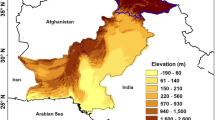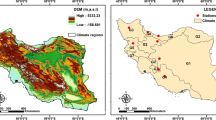Abstract
Climate change impacts all fields of life including agriculture. This study aimed to determine the historical and future climatic variations for the rainfed Prince Edward Island (PEI). Statistical downscaling model (SDSM), and support vector regression (SVR), multilayer perceptron (MLP), and random forest (RF) algorithms were applied to downscale climatic extremes, i.e., daily precipitation, maximum temperature (Tmax), and minimum temperature (Tmin) at 8 meteorological stations across the island for the baseline period (1976–2003). The MLP algorithm was further applied to project the climatic extremes for the future period (2006–2100) under three representative concentration pathways (RCP 2.6, RCP 4.5, and RCP 8.5) due to its better performance. Linear scaling was used to reduce the biases from the outputs of MLP. The annual and seasonal (potato growing season of May to October) outputs revealed that Tmax and Tmin are expected to increase in the future under all the RCPs, with the maximum increment observed for RCP 8.5. The increments in Tmax and Tmin for the growing season were 0.72–5.37 °C and 0.87–5.91 °C, respectively, irrespective of the RCPs. The spatial pattern of average annual precipitation in the growing season showed high (578–966 mm), moderate (558–625 mm), and low (449–664 mm) precipitation at the eastern, central, and western parts of PEI for both baseline and future periods. The highest changes were observed under RCP 8.5 as the warmest climate associated with this scenario. The projected precipitation extreme indices trends are likely to increase in the future. The maximum changes/year were observed under RCP8.5, which are 1.20 days/year for days with heavy precipitation (R10mm), 2.44 days/year for the days with very heavy precipitation (R20mm), 7.60 mm/year for total precipitation from heavy rainy days (R95p), 3.76 mm/year for total precipitation from very heavy precipitation days (R99p), 1.10 days/year for continuous wet days (CWD), and 0.08 mm/day for precipitation intensity (SDII) for a year. The findings of this study will help the farmers and government policymakers to get a clear picture of the climatic variability and strategize to mitigate the climate change impact on the island’s agriculture in the future.




Similar content being viewed by others
Data availability
Data will be made available on reasonable request.
References
Abbas F, Rehman I, Adrees M et al (2018) Prevailing trends of climatic extremes across Indus-Delta of Sindh-Pakistan. Theor Appl Climatol 131:1101–1117. https://doi.org/10.1007/s00704-016-2028-y
Afzaal H, Farooque AA, Abbas F et al (2020) Computation of evapotranspiration with artificial intelligence for precision water resource management. Appl Sci 10:1621. https://doi.org/10.3390/app10051621
Ahmed K, Shahid S, Bin HS, Xiao-jun W (2015) Multilayer perceptron neural network for downscaling rainfall in arid region: A case study of Baluchistan, Pakistan. J Earth Syst Sci 124:1325–1341. https://doi.org/10.1007/S12040-015-0602-9
Alexander L, Herold N (2016) ClimPACT2: indices and software. The University of South Wales, Sydney, Australia. https://github.com/ARCCSS-extremes/climpact2
Bhatti AZ, Farooque AA, Krouglicof N et al (2021) Climate change impacts on precipitation and temperature in Prince Edward Island, Canada. World Water Policy 7:9–29. https://doi.org/10.1002/WWP2.12046
Breiman L (2001) Random forests. Mach Learn 45:5–32. https://doi.org/10.1023/A:1010933404324
Campozano L, Tenelanda D, Sanchez E, Feyen J (2016) Comparison of statistical downscaling methods for monthly total precipitation: case study for the Paute River Basin in Southern Ecuador. Adv Meteorol. https://doi.org/10.1155/2016/6526341
Chen ST, Yu PS, Tang YH (2010) Statistical downscaling of daily precipitation using support vector machines and multivariate analysis. J Hydrol 385:13–22. https://doi.org/10.1016/J.JHYDROL.2010.01.021
Chim K, Tunnicliffe J, Shamseldin A, Chan K (2021) Identifying future climate change and drought detection using CanESM2 in the upper Siem Reap River, Cambodia. Dyn Atmos Ocean 94:101182. https://doi.org/10.1016/J.DYNATMOCE.2020.101182
Deen TA, Arain MA, Champagne O et al (2021) Evaluation of observed and projected extreme climate trends for decision making in Six Nations of the Grand River, Canada. Clim Serv 24:100263. https://doi.org/10.1016/J.CLISER.2021.100263
Dong S, Xu Y, Zhou B, Shi Y (2015) Assessment of indices of temperature extremes simulated by multiple CMIP5 models over China. Adv Atmos Sci 32:1077–1091. https://doi.org/10.1007/S00376-015-4152-5
Fan X, Jiang L, Gou J (2021) Statistical downscaling and projection of future temperatures across the Loess Plateau, China. Weather Clim Extrem 32:100328. https://doi.org/10.1016/J.WACE.2021.100328
Government of Canada (2013) All-weather precipitation gauge: weather instruments tour - Canada.ca. https://www.canada.ca/en/environment-climate-change/services/sky-watchers/weather-instruments-tour/all-precipitation-gauge.html. Accessed 17 May 2023
Government of Canada (2020) Climate change impacts on agriculture - agriculture.canada.ca. https://agriculture.canada.ca/en/environment/climate-scenarios-agriculture. Accessed 13 May 2023
Government of Canada (2021) Station Results - Historical Data - Climate - Environment and Climate Change Canada. https://climate.weather.gc.ca/historical_data/search_historic_data_e.html. Accessed 15 Sept 2021
Government of Canada (2019) CanESM2 predictors: CMIP5 experiments. https://climate-scenarios.canada.ca/?page=pred-canesm2. Accessed 16 Sept 2021
Government of PEI (2020) Agriculture on PEI. https://www.princeedwardisland.ca/en/information/agriculture-and-land/agriculture-pei. Accessed 15 Sept 2021
Government of PEI (2018) Our Changing Climate. https://www.princeedwardisland.ca/en/information/environment-energy-and-climate-action/our-changing-climate. Accessed 10 Oct 2021
Hasan DSNABPA, Ratnayake U, Shams S et al (2017) Prediction of climate change in Brunei Darussalam using statistical downscaling model. Theor Appl Climatol 133:343–360. https://doi.org/10.1007/S00704-017-2172-Z
Hashmi MZ, Shamseldin AY, Melville BW (2018) Comparison of MLP-ANN scheme and SDSM as tools for providing downscaled precipitation for impact studies at daily time scale. J Earth Sci Clim Change 09:475. https://doi.org/10.4172/2157-7617.1000475
Huang J, Zhang J, Zhang Z et al (2010) Estimation of future precipitation change in the Yangtze River basin by using statistical downscaling method. Stoch Environ Res Risk Assess 25:781–792. https://doi.org/10.1007/S00477-010-0441-9
IPCC (2021) Climate Change 2021: the physical science basis, Working Group 1 (WG1) contribution to the Sixth Assessment Report of the Intergovernmental Panel on Climate Change. Cambridge University Press, Cambridge. https://www.ipcc.ch/report/ar6/wg1/
Jimenez S, Aviles A, Galán L et al (2019) Support vector regression to downscaling climate big data: an application for precipitation and temperature future projection assessment. Adv Intell Syst Comput 1099:182–193. https://doi.org/10.1007/978-3-030-35740-5_13
Jing W, Yang Y, Yue X, Zhao X (2016) A spatial downscaling algorithm for satellite-based precipitation over the Tibetan Plateau based on NDVI, DEM, and land surface temperature. Remote Sens 8:655. https://doi.org/10.3390/RS8080655
Kendall MG (1948) Rank correlation methods. Griffin, Oxford
Kisi O, Cimen M (2011) A wavelet-support vector machine conjunction model for monthly streamflow forecasting. J Hydrol 399:132–140. https://doi.org/10.1016/J.JHYDROL.2010.12.041
Kisi O, Demir V (2016) Evapotranspiration estimation using six different multi-layer perceptron algorithms. Irrig Drain Syst Eng 5:1–6. https://doi.org/10.4172/2168-9768.1000164
Li G, Zhang X, Cannon AJ et al (2018) Indices of Canada’s future climate for general and agricultural adaptation applications. Clim Change 148:249–263. https://doi.org/10.1007/S10584-018-2199-X/FIGURES/5
Lima AR, Cannon AJ, Hsieh WW (2013) Nonlinear regression in environmental sciences by support vector machines combined with evolutionary strategy. Comput Geosci 50:136–144. https://doi.org/10.1016/J.CAGEO.2012.06.023
Lotfi M, Kamali GA, Meshkatee AH, Varshavian V (2020) Study on the impact of climate change on evapotranspiration in west of Iran. Arab J Geosci 13:1–11. https://doi.org/10.1007/s12517-020-05715-x
Mahmood R, Babel MS (2013) Evaluation of SDSM developed by annual and monthly sub-models for downscaling temperature and precipitation in the Jhelum basin, Pakistan and India. Theor Appl Climatol 113:27–44. https://doi.org/10.1007/s00704-012-0765-0
Mann HB (1945) Nonparametric tests against trend. Econom Soc 13:245–259. https://doi.org/10.2307/1907187
Maqsood J (2021) Machine learning based climate projections for sustainable potato production in Prince Edward Island. University of Prince Edward Island, Charlottetown, PE. https://islandscholar.ca/islandora/object/ir:24764/datastream/PDF/download/citation.pdf
Maqsood J, Farooque AA, Abbas F et al (2022) Application of artificial neural networks to project reference evapotranspiration under climate change scenarios. Water Resour Manag 2022:1–17. https://doi.org/10.1007/S11269-021-02997-Y
Maqsood J, Farooque AA, Wang X et al (2020) Contribution of climate extremes to variation in potato tuber yield in Prince Edward Island. Sustainability 12:4937. https://doi.org/10.3390/SU12124937
Mesoscale winter weather forecasting (2021) Basic ingredients of lake/ocean effect snow. http://stream1.cmatc.cn/pub/comet/WinterWeather/oceansnowcase/comet/norlat/snow/lake_effect/1_lo_snow_basic_ingredients.htm. Accessed 19 Oct 2021
Newton BW, Farjad B, Orwin JF (2021) Spatial and temporal shifts in historic and future temperature and precipitation patterns related to snow accumulation and melt regimes in Alberta, Canada. Water 13:1013. https://doi.org/10.3390/W13081013
Ning L, Riddle EE, Bradley RS (2015) Projected changes in climate extremes over the Northeastern United States. J Clim 28:3289–3310. https://doi.org/10.1175/JCLI-D-14-00150.1
NOAA (2021) What is a lake effect snow? https://www.weather.gov/safety/winter-lake-effect-snow. Accessed 16 Sept 2021
Nuri Balov M, Altunkaynak A (2019) Trend analyses of extreme precipitation indices based on downscaled outputs of global circulation models in Western Black Sea Basin, Turkey. Iran J Sci Technol Trans Civ Eng 43:821–834. https://doi.org/10.1007/S40996-019-00237-3
Pang B, Yue J, Zhao G, Xu Z (2017) Statistical downscaling of temperature with the random forest model. Adv Meteorol 2017:1–11. https://doi.org/10.1155/2017/7265178
Ren M, Pang B, Xu Z et al (2019) Downscaling of daily extreme temperatures in the Yarlung Zangbo River Basin using machine learning techniques. Theor Appl Climatol 136:1275–1288. https://doi.org/10.1007/s00704-018-2552-z
Richards W, Daigle R (2011) Scenarios and guidance for adaptation to climate change and sea level rise – NS and PEI municipalities. Atlantic Climate Adaptation Solutions Association, Halifax. http://www.gov.pe.ca/photos/original/ccscenarios.pdf
Sachindra DA, Huang F, Barton A, Perera BJC (2014) Statistical downscaling of general circulation model outputs to precipitation—part 1: calibration and validation. Int J Climatol 34:3264–3281. https://doi.org/10.1002/JOC.391410.1002/JOC.3914
Salmi T, Määttä A, Anttila P et al (2002) Detecting trends of annual values of atmospheric pollutants by the Mann-Kendall test and Sen’s slope estimates: the Excel Template Application MAKESENS. Finish metrological Institue Publications on Air Quality 31: Report Code FMI-AQ-31, Helsinki. https://www.researchgate.net/publication/259356944
Shahriar SA, Siddique MAM, Rahman SMA (2021) Climate change projection using statistical downscaling model over Chittagong Division, Bangladesh. Meteorol Atmos Phys 133:1409–1427. https://doi.org/10.1007/S00703-021-00817-X
Shi L, Feng P, Wang B et al (2020) Projecting potential evapotranspiration change and quantifying its uncertainty under future climate scenarios: A case study in southeastern Australia. J Hydrol 584:124756. https://doi.org/10.1016/j.jhydrol.2020.124756
Trenberth KE, Fasullo JT, Branstator G, Phillips AS (2014) Seasonal aspects of the recent pause in surface warming. Nat Clim Chang 4:911–916. https://doi.org/10.1038/nclimate2341
Trzaska S, Schnarr E (2014) A review of downscaling methods for climate change projections. United State Agency for International Development by Tetra Tech ARD, Washington, DC, pp 1–42. http://www.ciesin.org/documents/Downscaling_CLEARED_000.pdf
van Vuuren DP, Edmonds J, Kainuma M et al (2011) The representative concentration pathways: an overview. Clim Change 109:5–31. https://doi.org/10.1007/s10584-011-0148-z
Wang F, Tian D, Lowe L et al (2021) Deep learning for daily precipitation and temperature downscaling. Water Resour Res 57:e2020WR029308. https://doi.org/10.1029/2020WR029308
Wang S, Zhu J, Huang G et al (2020) Assessment of climate change impacts on energy capacity planning in Ontario, Canada using high-resolution regional climate model. J Clean Prod 274:123026. https://doi.org/10.1016/J.JCLEPRO.2020.123026
Wang X (2021) Mapping the spatial patterns of precipitation in Prince Edward Island. School of Climate Change and Adaptation, University of Prince Edward Island, Charlottetown. https://projects.upei.ca/xanderwang/files/2021/03/CCR_Report_003.pdf
Wilby RL, Dawson CW, Barrow EM (2002) SDSM - A decision support tool for the assessment of regional climate change impacts. Environ Model Softw 17:145–157. https://doi.org/10.1016/s1364-8152(01)00060-3
Zhang LEI, Xu Y, Meng C et al (2020) Comparison of statistical and dynamic downscaling techniques in generating high-resolution temperatures in China from CMIP5 GCMs. J Appl Meteorol Climatol 59:207–235. https://doi.org/10.1175/JAMC-D-19-0048.1
Acknowledgements
The authors are thankful to the precision agriculture team of the University of Prince Edward Island, Canada for their research support.
Funding
This research was funded by the Natural Science and Engineering Research Council of Canada.
Author information
Authors and Affiliations
Contributions
Conceptualization: Junaid Maqsood, Aitazaz A. Farooque, Farhat Abbas, Hassan Afzaal; Data curation: Hassan Afzaal, Xander Wang; Methodology: Junaid Maqsood, Farhat Abbas; Formal analysis and investigation: Junaid Maqsood, Hassan Afzaal; Validation: Aitazaz A. Farooque, Xander Wang, Travis Esau; Writing – original draft preparation: Junaid Maqsood, Farhat Abbas, Aitazaz A. Farooque; Writing – review and editing: Xander Wang, Travis Esau; Supervision: Aitazaz A. Farooque; Resources: Aitazaz A. Farooque, Farhat Abbas; Funding acquisition: Aitazaz A. Farooque.
Corresponding author
Ethics declarations
Ethical approval
Not applicable.
Consent to participate and publication
All authors give their consent to participate and publish.
Competing interests
The authors declare no competing interests.
Additional information
Publisher's note
Springer Nature remains neutral with regard to jurisdictional claims in published maps and institutional affiliations.
Rights and permissions
Springer Nature or its licensor (e.g. a society or other partner) holds exclusive rights to this article under a publishing agreement with the author(s) or other rightsholder(s); author self-archiving of the accepted manuscript version of this article is solely governed by the terms of such publishing agreement and applicable law.
About this article
Cite this article
Maqsood, J., Afzaal, H., Farooque, A.A. et al. Statistical downscaling and projection of climatic extremes using machine learning algorithms. Theor Appl Climatol 153, 1033–1047 (2023). https://doi.org/10.1007/s00704-023-04532-y
Received:
Accepted:
Published:
Issue Date:
DOI: https://doi.org/10.1007/s00704-023-04532-y




